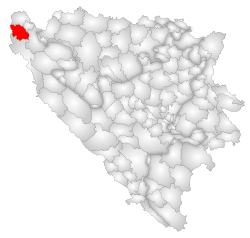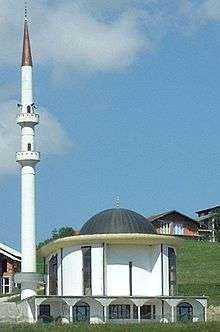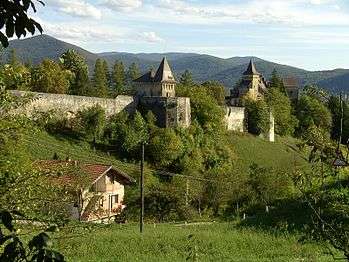Cazin
| Cazin Цазин | |
|---|---|
| Municipality and town | |
 | |
 Location of Cazin within Bosnia and Herzegovina. | |
 Cazin Location of Cazin | |
| Coordinates: 44°58′N 15°56′E / 44.967°N 15.933°ECoordinates: 44°58′N 15°56′E / 44.967°N 15.933°E | |
| Country | Bosnia and Herzegovina |
| Government | |
| • Municipality president | Nermin Ogrešević (A-SDA) |
| Area | |
| • Total | 356 km2 (137 sq mi) |
| Population (Census 2013 [1]) | |
| • Total | 69,411 |
| • Density | 195/km2 (510/sq mi) |
| Time zone | CET (UTC+1) |
| • Summer (DST) | CEST (UTC+2) |
| Area code(s) | +387 37 |
| Website | http://www.cazin.net |

.jpg)
Cazin is a town and municipality in northwest Bosnia and Herzegovina in the Bosanska Krajina region, near the border with Croatia. It is located in the Una-Sana Canton of the Federation of Bosnia and Herzegovina. The municipality is often also called Cazinska Krajina. The town of Cazin is located on the main road which connects Bihać and Velika Kladuša.
History and features
Cazin has several historic places, some dating back to the 14th century. Ostrožac castle and Radetina Tower are located in Cazin.
From 1929 to 1941, Cazin was part of the Vrbas Banovina of the Kingdom of Yugoslavia.
The Cazin uprising of 1950, an armed anti-state rebellion of peasants, occurred in Cazin and neighboring Velika Kladuša and Slunj, which were all part of Communist Yugoslavia at the time.[2] The peasants revolted against the forced collectivization and collective farms by the Yugoslav government on the farmers of its country. Following a drought in 1949, the peasants of Yugoslavia were unable to meet unrealistic quotas set by their government and were punished. The revolt that followed the drought resulted in the killings and persecution of those who organized the uprising, but also many innocent civilians.[3][4] It was the only peasant rebellion in the history of Cold War Europe.[5]
The city was successfully defended by the Bosnian Army during the War in Bosnia and Herzegovina.
Demographics
1971
According to the 1971 census the municipality had 45,468 residents, including:
- 43,880 Bosniaks (98.50%)
- 1,196 Serbs (2.71%)
- 175 Croats (0.38%)
- 51 Yugoslavs (0.11%)
- 166 others (0.36%)
1981
According to the 1981 census the municipality had 57,110 residents, including:
- 55,401 Bosniaks (97.00%)
- 826 Serbs (1.44%)
- 122 Croats (0.21%)
- 529 Yugoslavs (0.92%)
- 232 others (0.40%)
1991
According to the 1991 census the municipality of Cazin had 63,409 residents, including:
- 61,693 Bosniaks (98.29%)
- 778 Serbs (0.22%)
- 139 Croats (0.21%)
- 430 Yugoslavs (0.67%)
- 369 others (0.58%)
2013
According to the 2013 census the municipality of Cazin had 66,149 residents, including:
- 63,463 Bosniaks (95.93%)
- 29 Serbs (0.04%)
- 320 Croats (0.48%)
- 2,337 others (3.53%)
Settlements
• Bajrići • Brezova Kosa • Bukovica • Cazin • Crnaja • Čajići • Čizmići • Ćehići • Ćoralići • Donja Barska • Donja Koprivna • Donja Lučka • Glogovac • Gornja Barska • Gornja Koprivna • Gornja Lučka • Gradina • Hadžin Potok • Kapići • Kličići • Kovačevići • Krakača • Krivaja • Liđani • Liskovac • Ljubijankići • Majetići • Miostrah • Mujakići • Mutnik • Osredak • Ostrožac • Ostrožac na Uni • Pećigrad • Pivnice • Pjanići • Podgredina • Polje • Ponjevići • Prošići • Rošići • Rujnica • Skokovi • Stijena • Šturlić • Šturlićka Platnica • Toromani • Tržac • Tržačka Platnica • Tržačka Raštela • Urga • Vilenjača • Vrelo • Zmajevac
 Cazin fortress
Cazin fortress Cazin fortress
Cazin fortress
See also
External links
References
- ↑ http://www.bhas.ba/obavjestenja/Preliminarni_rezultati_bos.pdf
- ↑ "CAZINSKA BUNA 1950: Danas se navršavaju 62 godine od ustanka u Krajini". Cazin. 6 May 2012. Retrieved 11 February 2014.
- ↑ "Klanjana kolektivna dženaza žrtvama Cazinske bune iz 1950. godine". Haber. 11 May 2012. Retrieved 11 February 2014.
- ↑ "Vera Kržišnik Bukić i Cazinska buna". Radio Sarajevo. 4 May 2012. Retrieved 11 February 2014.
- ↑ "Rock and Hard Places: Travels to Backstages, Frontlines and Assorted Sideshows". Google Books. 2010. Retrieved 11 February 2014.
| Wikimedia Commons has media related to Cazin. |